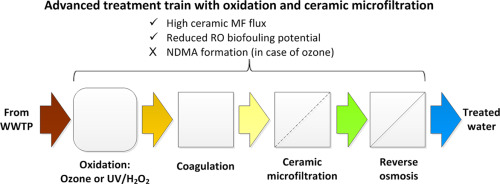当前位置:
X-MOL 学术
›
Desalination
›
论文详情
Our official English website, www.x-mol.net, welcomes your
feedback! (Note: you will need to create a separate account there.)
Effect of oxidation with coagulation and ceramic microfiltration pre-treatment on reverse osmosis for desalination of recycled wastewater
Desalination ( IF 8.3 ) Pub Date : 2018-04-01 , DOI: 10.1016/j.desal.2017.10.029 D.T. Myat , F. Roddick , P. Puspita , L. Skillman , J. Charrois , I. Kristiana , W. Uhl , E. Vasyukova , G. Roeszler , A. Chan , B. Zhu , S. Muthukumaran , S. Gray , M. Duke
Desalination ( IF 8.3 ) Pub Date : 2018-04-01 , DOI: 10.1016/j.desal.2017.10.029 D.T. Myat , F. Roddick , P. Puspita , L. Skillman , J. Charrois , I. Kristiana , W. Uhl , E. Vasyukova , G. Roeszler , A. Chan , B. Zhu , S. Muthukumaran , S. Gray , M. Duke

|
Abstract Oxidation and coagulation before ceramic microfiltration (CMF) greatly increases membrane flux, but is unconventional for reverse osmosis (RO) pre-treatment. Impacts to RO and the wastewater recycling scheme operating CMF at high flux conditions is little understood. In this work, wastewater was treated with ozone or ultraviolet/hydrogen peroxide (UVH) oxidation, coagulation, then CMF, to explore RO membrane performance at bench scale. Sustainable high CMF fluxes were confirmed using coagulation with either ozone or UVH. Uniquely for ozone, dosing 13 mg-O3/L for 15 min greatly increased toxic by-product N-nitrosodimethylamine (NDMA) to 33 ng/L. Dosing chloramine (common for RO biofouling control) added only up to 7 ng/L NDMA. RO tests on all pre-treated waters showed little variation to flux but oxidation significantly altered texture of RO fouling material from smooth and dense to porous and granular. Biofouling studies with model bacteria strain RO 22 (Pseudoalteromonas spp) showed higher organic biodegradability but biofilm analysis revealed ozone-coagulant-CMF greatly limited extension of bacteria communities from the membrane surface suggesting oxidation reduces RO biofouling. The novel findings of reduction of RO biofouling risk with oxidation and coagulation for high flux CMF pre-treatment identified in this work need to be demonstrated on different wastewater types over longer term.
中文翻译:

混凝氧化和陶瓷微滤预处理对反渗透再生废水脱盐的影响
摘要 陶瓷微滤 (CMF) 前的氧化和混凝大大提高了膜通量,但对于反渗透 (RO) 预处理来说是非常规的。对 RO 和在高通量条件下运行 CMF 的废水回收计划的影响知之甚少。在这项工作中,废水经过臭氧或紫外线/过氧化氢 (UVH) 氧化、混凝和 CMF 处理,以在实验室规模上探索 RO 膜的性能。使用臭氧或 UVH 凝结证实了可持续的高 CMF 通量。臭氧的独特之处在于,在 15 分钟内以 13 毫克-O3/L 的剂量给药会大大增加有毒副产物 N-亚硝基二甲胺 (NDMA) 至 33 ng/L。添加氯胺(常用于 RO 生物污垢控制)仅添加至 7 ng/L NDMA。对所有预处理水的 RO 测试显示通量变化很小,但氧化显着改变了 RO 污垢材料的质地,从光滑和致密到多孔和颗粒状。对模型细菌菌株 RO 22(假交替单胞菌属)的生物污染研究显示出更高的有机生物降解性,但生物膜分析显示臭氧凝结剂 CMF 极大地限制了细菌群落从膜表面的扩展,表明氧化减少了 RO 生物污染。在这项工作中确定的高通量 CMF 预处理通过氧化和凝结降低 RO 生物污垢风险的新发现需要在不同废水类型上进行长期证明。对模型细菌菌株 RO 22(假交替单胞菌属)的生物污染研究显示出更高的有机生物降解性,但生物膜分析显示臭氧凝结剂 CMF 极大地限制了细菌群落从膜表面的扩展,表明氧化减少了 RO 生物污染。在这项工作中确定的高通量 CMF 预处理通过氧化和凝结降低 RO 生物污垢风险的新发现需要在不同废水类型上进行长期证明。对模型细菌菌株 RO 22(假交替单胞菌属)的生物污染研究显示出更高的有机生物降解性,但生物膜分析显示臭氧凝结剂 CMF 极大地限制了细菌群落从膜表面的扩展,表明氧化减少了 RO 生物污染。在这项工作中确定的高通量 CMF 预处理通过氧化和凝结降低 RO 生物污垢风险的新发现需要在不同废水类型上进行长期证明。
更新日期:2018-04-01
中文翻译:

混凝氧化和陶瓷微滤预处理对反渗透再生废水脱盐的影响
摘要 陶瓷微滤 (CMF) 前的氧化和混凝大大提高了膜通量,但对于反渗透 (RO) 预处理来说是非常规的。对 RO 和在高通量条件下运行 CMF 的废水回收计划的影响知之甚少。在这项工作中,废水经过臭氧或紫外线/过氧化氢 (UVH) 氧化、混凝和 CMF 处理,以在实验室规模上探索 RO 膜的性能。使用臭氧或 UVH 凝结证实了可持续的高 CMF 通量。臭氧的独特之处在于,在 15 分钟内以 13 毫克-O3/L 的剂量给药会大大增加有毒副产物 N-亚硝基二甲胺 (NDMA) 至 33 ng/L。添加氯胺(常用于 RO 生物污垢控制)仅添加至 7 ng/L NDMA。对所有预处理水的 RO 测试显示通量变化很小,但氧化显着改变了 RO 污垢材料的质地,从光滑和致密到多孔和颗粒状。对模型细菌菌株 RO 22(假交替单胞菌属)的生物污染研究显示出更高的有机生物降解性,但生物膜分析显示臭氧凝结剂 CMF 极大地限制了细菌群落从膜表面的扩展,表明氧化减少了 RO 生物污染。在这项工作中确定的高通量 CMF 预处理通过氧化和凝结降低 RO 生物污垢风险的新发现需要在不同废水类型上进行长期证明。对模型细菌菌株 RO 22(假交替单胞菌属)的生物污染研究显示出更高的有机生物降解性,但生物膜分析显示臭氧凝结剂 CMF 极大地限制了细菌群落从膜表面的扩展,表明氧化减少了 RO 生物污染。在这项工作中确定的高通量 CMF 预处理通过氧化和凝结降低 RO 生物污垢风险的新发现需要在不同废水类型上进行长期证明。对模型细菌菌株 RO 22(假交替单胞菌属)的生物污染研究显示出更高的有机生物降解性,但生物膜分析显示臭氧凝结剂 CMF 极大地限制了细菌群落从膜表面的扩展,表明氧化减少了 RO 生物污染。在这项工作中确定的高通量 CMF 预处理通过氧化和凝结降低 RO 生物污垢风险的新发现需要在不同废水类型上进行长期证明。











































 京公网安备 11010802027423号
京公网安备 11010802027423号